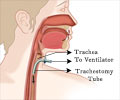Tracheostomy - Faqs
1. Which doctor performs tracheostomy?An ENT specialist surgeon is the doctor who performs tracheostomy.
2. How painful was the surgery?
There is very little pain immediately after the surgery that could be compared to a moderate headache.
3. What kind of anaesthesia do they use for the surgery?
The trach surgery is generally done under local anaesthesia but sometimes it is done under general anaesthesia.
4. How long does it take to heal?
It depends on the reason for which the procedure is being undertaken. If it were for simple obstruction or simple causes like 'sleep apnoea' then it generally would heal in about 7 days after the surgery.









